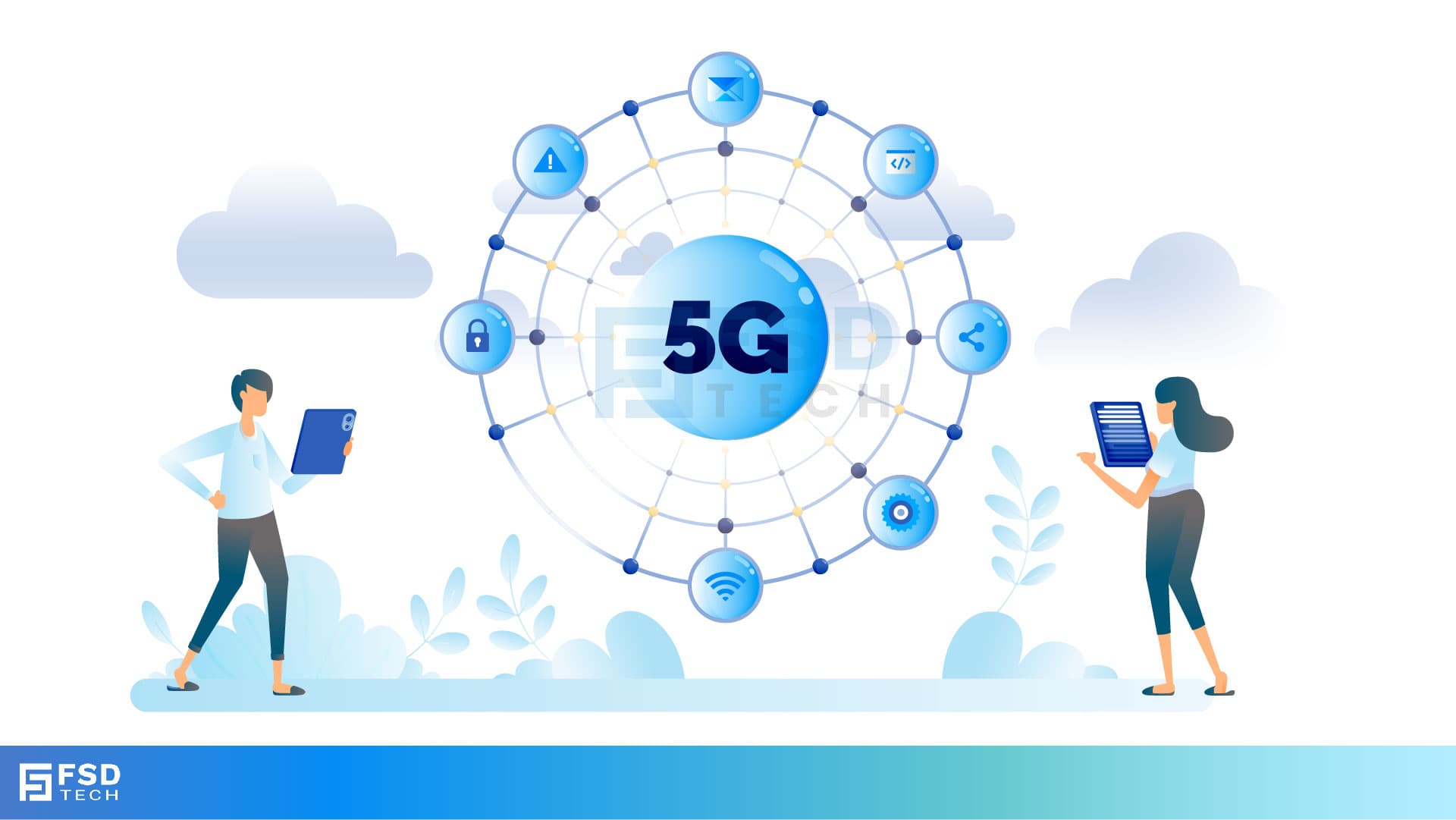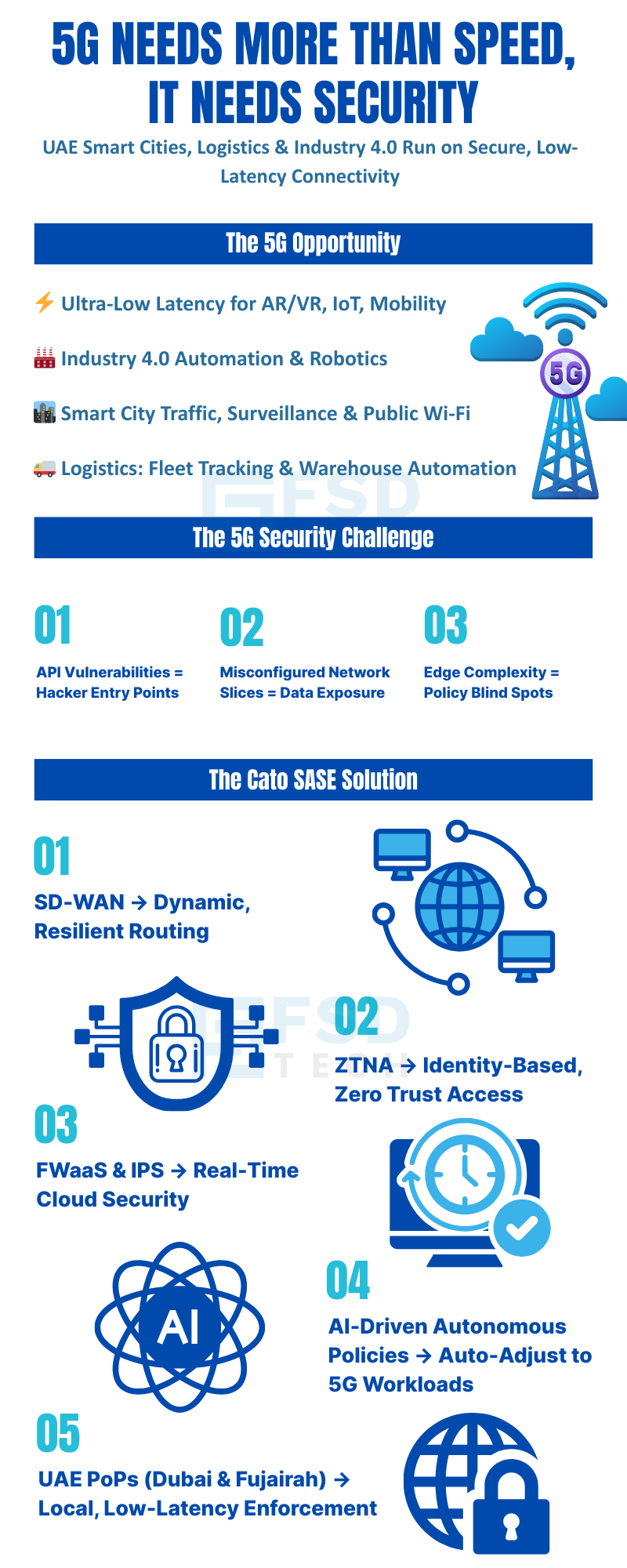
WAN Recovery Tunnel Status in Cato SASE: Readiness You Can See
🕓 September 30, 2025

The United Arab Emirates stands at the vanguard of 5G adoption, with cities like Dubai and Abu Dhabi investing heavily in next-generation mobile networks. These deployments are foundational for smart city initiatives, advanced logistics, connected mobility, and Industry 4.0 facilities. The promise is clear: ultra-fast, low-latency connectivity that enables real-time data flows, automation, and digital transformation at scale.
However, the shift to 5G also brings new complexities. The proliferation of edge devices, APIs, and network slices expands the attack surface. Enterprises and public sector organizations must secure a vastly more dynamic and distributed environment, all while meeting stringent local compliance requirements and maintaining operational agility.
For UAE-based enterprises and government entities, 5G is not just about speed—it’s about trust, resilience, and compliance. Mission-critical applications—from smart traffic systems to industrial robotics—depend on uninterrupted, secure connectivity. Any compromise in security or performance can have immediate, far-reaching consequences, whether it’s a data breach, service outage, or regulatory infraction.
This is where Cato SASE, enabled by FSD Tech, delivers a decisive advantage: unified, cloud-native security and networking, purpose-built for the demands of 5G.
Secure your 5G transformation today with unified SASE protection. Click Here
5G’s leap in bandwidth and latency unlocks a host of transformative applications:
These use cases demand not only high throughput but also deterministic, low-latency performance—requirements that legacy network architectures struggle to meet.
The same features that make 5G powerful also introduce new security challenges:
For UAE organizations, these risks are amplified by the scale and diversity of 5G-enabled projects, from smart ports to nationwide logistics.
Secure Access Service Edge (SASE) is a cloud-native architecture that converges networking and security functions into a unified, globally distributed service. Key components include:
SASE’s convergence eliminates the need for disparate appliances and manual integrations, streamlining operations and reducing attack surfaces.
Traditional security models route traffic back to centralized data centers for inspection—a process that introduces latency and creates bottlenecks, especially in mobile-first or distributed environments. SASE, by contrast, enforces security policies directly at the cloud edge, close to users and devices.
For 5G deployments in the UAE, this means:
5G’s dynamic, multi-tenant environments require granular, adaptive security. Zero Trust principles—never trust, always verify—are essential:
Cato SASE’s ZTNA and microsegmentation capabilities are particularly well-suited to the fluid, high-mobility nature of 5G workloads.
Cato Networks, in partnership with e& (formerly Etisalat), has established new Points-of-Presence in Dubai and Fujairah. These PoPs leverage e&’s SmartHub data centers, providing:
For organizations with UAE-based operations or compliance requirements, these local PoPs ensure that sensitive data remains within national borders, supporting data residency and privacy mandates.
Cato’s Autonomous Policies engine uses AI to automate the entire security policy lifecycle:
This is especially valuable in 5G environments, where endpoints and workloads are constantly shifting.
Unlike legacy solutions that rely on physical appliances and complex integrations, Cato SASE is fully cloud-managed:
For UAE enterprises scaling 5G infrastructure, this operational simplicity translates to faster time-to-value and reduced total cost of ownership.
FSD Tech plays a pivotal role in enabling secure, high-performance 5G deployments across the UAE and GCC:
This local expertise ensures that Cato SASE deployments are not only technically robust but also aligned with the unique operational and regulatory context of the region.
Consider a Dubai municipality deploying a smart city mobility network:
This model can be replicated across other smart city, industrial, and logistics projects throughout the GCC.
See how your organization can achieve the same 5G security success — get started now.
FSD Tech’s services extend beyond initial deployment:
This partnership approach accelerates digital transformation while minimizing risk and complexity.
Cato SASE, enabled by FSD Tech, is ideally suited for smart city initiatives:
Local PoPs in Dubai and Fujairah ensure that all data remains within UAE borders, supporting compliance and sovereignty.
Manufacturing and industrial organizations in Abu Dhabi and across the UAE are leveraging 5G for:
Cato SASE’s Zero Trust access and microsegmentation prevent lateral movement in case of device compromise, while AI-driven policies adapt to dynamic production environments.
For logistics providers and mobility services:
Cato SASE’s cloud-native architecture ensures consistent security and performance, even as assets move across regions or connect from remote locations.
Book a consultation with our experts to design your 5G-ready SASE roadmap. Book Now

Cato SASE enforces security policies directly at the cloud edge, close to 5G endpoints, rather than backhauling traffic to centralized data centers. This approach minimizes latency and ensures that security inspection and policy enforcement occur in real time, regardless of user or device location. The result is consistent, scalable protection for distributed 5G environments, without the complexity or bottlenecks of appliance-based solutions.
Cato SASE is designed to address key 5G threats such as API vulnerabilities, network slicing misconfigurations, and downgrade attacks. By converging advanced security functions—including Firewall-as-a-Service (FWaaS), Intrusion Prevention System (IPS), and Zero Trust Network Access (ZTNA)—Cato SASE provides adaptive, identity-based controls that protect against unauthorized access, lateral movement, and protocol exploits unique to 5G networks.
FSD Tech acts as a regional integration partner, providing expertise in edge routing, dynamic ZTNA policy design, compliance management, and ongoing optimization. Their local knowledge ensures that Cato SASE deployments are tailored to UAE and GCC regulatory requirements and operational realities, from initial design through continuous support and tuning.
Yes. Cato SASE’s UAE-based Points-of-Presence in Dubai and Fujairah allow organizations to keep sensitive data within national borders, supporting compliance with local data residency and privacy mandates. The platform’s cloud-native architecture also enables granular policy controls and auditability, further simplifying regulatory alignment.
Enterprises and public sector entities deploying smart city solutions, industrial automation, logistics, and mobile-first applications benefit significantly from Cato SASE’s secure, high-performance 5G connectivity. The platform is particularly valuable for organizations with distributed sites, mobile endpoints, or stringent compliance requirements across the UAE and GCC.
Cato SASE implements Zero Trust Network Access (ZTNA) by authenticating and authorizing every connection based on user identity, device posture, and contextual factors. This ensures that only verified users and devices can access specific applications or resources, regardless of their network location. For 5G environments, this approach prevents unauthorized access and limits the impact of compromised endpoints.
Adaptive microsegmentation refers to dynamically segmenting network traffic at a granular level, based on real-time context such as user, device, application, and location. In 5G environments—where endpoints and workloads are highly dynamic—adaptive microsegmentation limits lateral movement, contains breaches, and enforces least-privilege access, all without manual intervention.
Cato SASE’s Autonomous Policies engine uses AI to automate the creation, enforcement, and adjustment of security policies. This reduces manual errors, accelerates response to emerging threats, and ensures that security controls adapt in real time as users, devices, and applications move across the 5G network. The result is more resilient, scalable protection for complex, high-mobility environments.
The Points-of-Presence in Dubai and Fujairah serve as regional gateways for traffic inspection, routing, and policy enforcement. By processing data locally, these PoPs reduce latency, improve performance, and support compliance with UAE data residency requirements. They also provide direct interconnectivity with e& SmartHub data centers, optimizing global data transfer for UAE-based organizations.
Cato SASE is fully cloud-managed, eliminating the need for physical appliances, manual patching, or complex integrations. UAE enterprises can onboard new sites, users, or devices rapidly, manage policies centrally, and benefit from continuous updates delivered via the cloud. This operational simplicity accelerates 5G adoption while reducing total cost of ownership.
Yes. Cato SASE is designed to provide secure, high-performance connectivity for remote workers, mobile devices, and distributed assets. Using identity-based access controls and cloud-native inspection, the platform ensures consistent protection and policy enforcement, regardless of endpoint location or network.
Cato SASE can enforce distinct security policies for different network slices, ensuring that each slice—whether dedicated to IoT, critical infrastructure, or public services—receives tailored protection. This prevents misconfigurations or vulnerabilities in one slice from impacting others, supporting secure multi-tenancy and service isolation.
Cloud-native SASE platforms like Cato eliminate the need for on-premises hardware, enabling rapid scaling and centralized management across multiple industrial sites. For GCC organizations deploying Industry 4.0 solutions, this means faster time-to-value, reduced operational complexity, and consistent enforcement of security and compliance policies across all locations.
FSD Tech provides continuous monitoring, policy refinement, and support services tailored to the evolving needs of UAE and GCC organizations. Their expertise ensures that Cato SASE environments remain aligned with business objectives, regulatory changes, and emerging threat landscapes, maximizing the value of 5G investments.
Yes. For example, a Dubai municipality used Cato SASE and FSD Tech to secure a smart city mobility network, protecting 5G-connected traffic signals and surveillance systems with edge-based ZTNA and adaptive microsegmentation. Similarly, an Abu Dhabi manufacturing facility leveraged the platform to enforce Zero Trust access for IoT sensors and robotics, ensuring compliance with UAE data residency regulations.
Cato SASE enables real-time, secure connectivity for logistics fleets, warehouses, and mobile endpoints by providing low-latency routing, identity-based access controls, and centralized policy management. This ensures that field staff, vehicles, and assets remain protected and connected, even as they move across regions or network boundaries.
The combination of Cato SASE’s unified, cloud-native architecture and FSD Tech’s regional integration expertise delivers a solution tailored to the unique operational, regulatory, and performance needs of UAE and GCC organizations. This partnership ensures secure, scalable, and compliant 5G connectivity for mission-critical applications across smart cities, industry, and logistics.

Anas is an Expert in Network and Security Infrastructure, With over seven years of industry experience, holding certifications Including CCIE- Enterprise, PCNSE, Cato SASE Expert, and Atera Certified Master. Anas provides his valuable insights and expertise to readers.
Share it with friends!

🕓 September 30, 2025
.jpg&w=3840&q=75)
🕓 September 29, 2025

🕓 September 27, 2025
share your thoughts